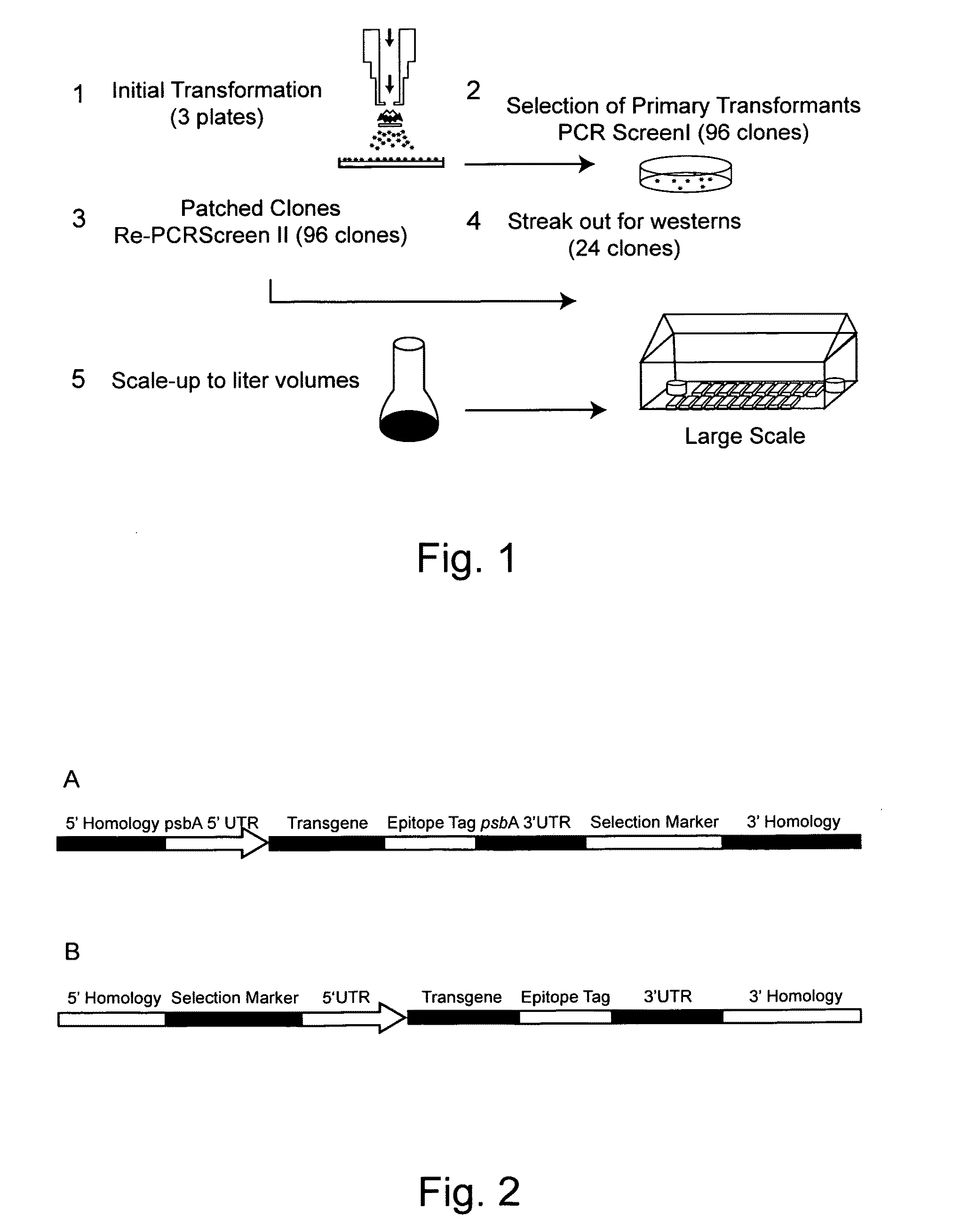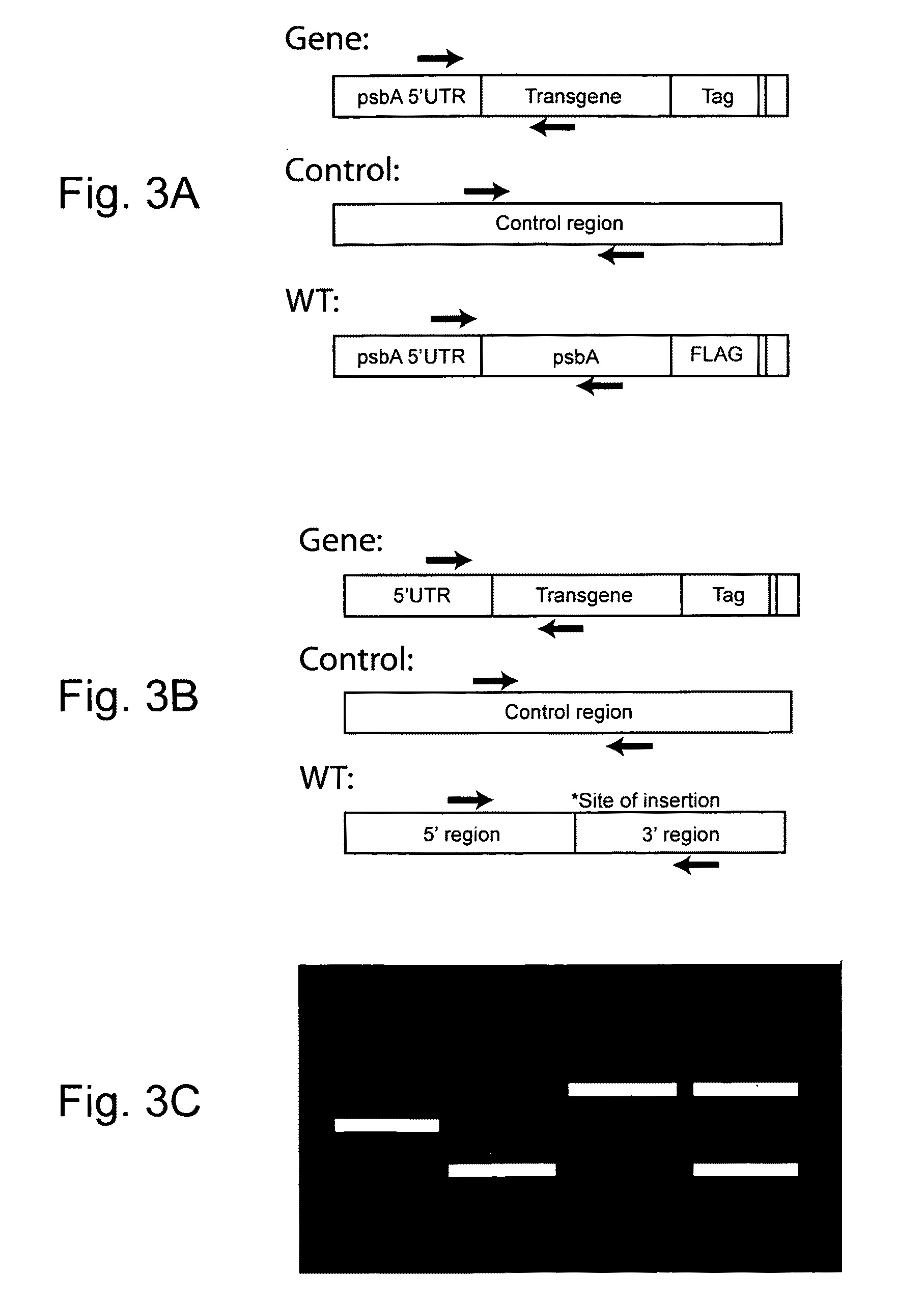Use of genetically modified organisms to generate biomass degrading enzymes
a technology of genetically modified organisms and enzymes, which is applied in the direction of microorganisms, biofuels, enzymes, etc., can solve the problems of increasing fuel costs, economic prohibitive use of fuel, and complex procedures, and achieves stable transformation and stable transformation of
- Summary
- Abstract
- Description
- Claims
- Application Information
AI Technical Summary
Benefits of technology
Problems solved by technology
Method used
Image
Examples
example 1
Production of Endo-β-glucanase in C. reinhardtii
[0115]In this example a nucleic acid encoding endo-β-glucanase from T. reesei was introduced into C. reinhardtii. Transforming DNA (SEQ ID NO. 20, Table 4) is shown graphically in FIG. 2A. In this instance the segment labeled “Transgene” is the endo-β-glucanase encoding gene (SEQ ID NO. 16, Table 3), the segment labeled “psbA 5′ UTR” is the 5′ UTR and promoter sequence for the psbA gene from C. reinhardtii, the segment labeled “psbA 3′ UTR” contains the 3′ UTR for the psbA gene from C. reinhardtii, and the segment labeled “Selection Marker” is the kanamycin resistance encoding gene from bacteria, which is regulated by the 5′ UTR and promoter sequence for the atpA gene from C. reinhardtii and the 3′ UTR sequence for the rbcL gene from C. reinhardtii. The transgene cassette is targeted to the psbA loci of C. reinhardtii via the segments labeled “5′ Homology” and “3′ Homology,” which are identical to sequences of DNA flanking the psbA lo...
example 2
Production of Exo-β-glucanase in C. reinhardtii
[0123]In this example a nucleic acid encoding exo-β-glucanase from T. viride was introduced into C. reinhardtii. Transforming DNA (SEQ ID NO. 19, Table 4) is shown graphically in FIG. 2A. In this instance the segment labeled “Transgene” is the exo-β-glucanase encoding gene (SEQ ID NO. 15, Table 3), the segment labeled “psbA 5′ UTR” is the 5′ UTR and promoter sequence for the psbA gene from C. reinhardtii, the segment labeled “psbA 3′ UTR” contains the 3′ UTR for the psbA gene from C. reinhardtii, and the segment labeled “Selection Marker” is the kanamycin resistance encoding gene from bacteria, which is regulated by the 5′ UTR and promoter sequence for the atpA gene from C. reinhardtii and the 3′ UTR sequence for the rbcL gene from C. reinhardtii. The transgene cassette is targeted to the psbA loci of C. reinhardtii via the segments labeled “5′ Homology” and “3′ Homology,” which are identical to sequences of DNA flanking the psbA locus...
example 3
Production of β-glucosidase in C. reinhardtii
[0131]In this example a nucleic acid encoding β-glucosidase from T. reesei was introduced into C. reinhardtii. Transforming DNA (SEQ ID NO. 21, Table 4) is shown graphically in FIG. 2A. The amino acid sequence encoded by this gene is shown in Table 3. In this instance the segment labeled “Transgene” is the β-glucosidase encoding gene (SEQ ID NO. 17, Table 3), the segment labeled “psbA 5′ UTR” is the 5′ UTR and promoter sequence for the psbA gene from C. reinhardtii, the segment labeled “psbA 3′ UTR” contains the 3′ UTR for the psbA gene from C. reinhardtii, and the segment labeled “Selection Marker” is the kanamycin resistance encoding gene from bacteria, which is regulated by the 5′ UTR and promoter sequence for the atpA gene from C. reinhardtii and the 3′ UTR sequence for the rbcL gene from C. reinhardtii. The transgene cassette is targeted to the psbA loci of C. reinhardtii via the segments labeled “5′ Homology” and “3′ Homology,” whi...
PUM
| Property | Measurement | Unit |
|---|---|---|
| pH | aaaaa | aaaaa |
| pH | aaaaa | aaaaa |
| time | aaaaa | aaaaa |
Abstract
Description
Claims
Application Information
 Login to View More
Login to View More - Generate Ideas
- Intellectual Property
- Life Sciences
- Materials
- Tech Scout
- Unparalleled Data Quality
- Higher Quality Content
- 60% Fewer Hallucinations
Browse by: Latest US Patents, China's latest patents, Technical Efficacy Thesaurus, Application Domain, Technology Topic, Popular Technical Reports.
© 2025 PatSnap. All rights reserved.Legal|Privacy policy|Modern Slavery Act Transparency Statement|Sitemap|About US| Contact US: help@patsnap.com



